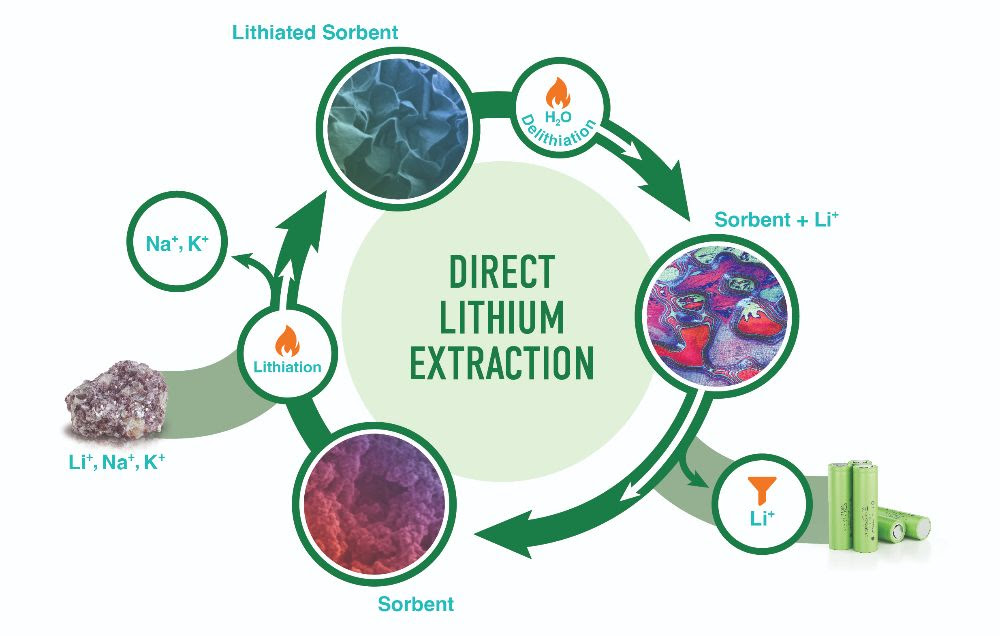
13 Climate Action (128)
Take urgent action to combat climate change and its impacts
HBG Program: Cryptocurrencies and Climate Change Casualties
KNOXVILLE — John Nolt, a member of the Sierra Club’s Harvey Broome Group executive committee and professor emeritus in philosophy at the University of Tennessee, will present a program about cryptocurrencies and their detrimental long-term effects on the environment. Cryptocurrency “mines” (data centers, really) pull enormous quantities of power from the electrical grid.
Thus they are attracted to states like Tennessee where electric power is relatively cheap.
The event is set for 7-8:30 p.m. June 11 at the Tennessee Valley Unitarian Universalist Church, 2931 Kingston Pike, Knoxville.
Learn about TVA’s switch from coal to natural gas at June 12 teach-in

Chattanooga Earth Day Week continues
ORNL chemists invent a more efficient way to extract lithium
 Oak Ridge National Laboratory
Oak Ridge National Laboratory
OAK RIDGE — Chemists at the Department of Energy’s Oak Ridge National Laboratory have invented a more efficient way to extract lithium from waste liquids leached from mining sites, oil fields and used batteries. They demonstrated that a common mineral can adsorb at least five times more lithium than can be collected using previously developed adsorbent materials.
“It’s a low-cost, high-lithium-uptake process,” said Parans Paranthaman, an ORNL Corporate Fellow and National Academy of Inventors Fellow with 58 issued patents. He led the proof-of-concept experiment with Jayanthi Kumar, an ORNL materials chemist with expertise in the design, synthesis and characterization of layered materials.
“The key advantage is that it works in a wider pH range of 5 to 11 compared to other direct lithium extraction methods,” Paranthaman said. The acid-free extraction process takes place at 140 degrees Celsius, compared to traditional methods that roast mined minerals at 250 degrees Celsius with acid or 800 to 1,000 degrees Celsius without acid.
Lithium is a lightweight metal commonly used in energy-dense and rechargeable batteries. Electric vehicles, which are needed to achieve net-zero emissions by 2050, rely on lithium-ion batteries. Industrially, lithium is extracted from brines, rocks and clays. The ORNL innovation may help meet rising demand for lithium by making domestic sources commercially viable.
Momentum builds slowly for TVA’s post-coal plans
Written by Ben Pounds Supercomputer simulation of plasma turbulence in a spherical tokamak, which is an experimental machine designed to harness the energy of fusion. Image courtesy of Walter Guttenfelder, Princeton Plasma Physics Laboratory and Filippo Scotti, Lawrence Livermore National Laboratory via DOE.
Supercomputer simulation of plasma turbulence in a spherical tokamak, which is an experimental machine designed to harness the energy of fusion. Image courtesy of Walter Guttenfelder, Princeton Plasma Physics Laboratory and Filippo Scotti, Lawrence Livermore National Laboratory via DOE.
Fusion research, natural gas, solar power and battery improvements at heart of TVA’s plans to wean itself off coal
OAK RIDGE — The Tennessee Valley Authority is phasing out coal and announcing developments tied to other energy sources at two plants that sit on either side of Oak Ridge.
One of the options includes a fusion test site. Scientists have long pursued fusion energy, though the technology remains in infancy and has yet to generate electricity anywhere.
The TVA coal plant on Edgemoor Road in the Claxton community in Anderson County closed Dec. 1 last year. TVA remains uncommitted to any plans for most of the land around the plant. A company recently announced, however, that it plans tests connected to fusion power in a small part of one of Bull Run’s old buildings by 2028. It will be an experiment and not generate power directly.
Meanwhile, TVA plans to retire Kingston Fossil Plant on Swan Pond Road in Harriman by the end of 2027. Its nine coal-fired units power about 818,000 homes. To replace the power generated at the plant, TVA plans to build a new complex at the Kingston plant’s site, combining natural gas, solar power and battery storage.
TVA plans to retire all its coal plants by the 2030s.
 Methane emissions, such as those that emanate from this oil well on federal property, are being capped across federal land in the Southeast thanks to a Biden Administration grant. NPS
Methane emissions, such as those that emanate from this oil well on federal property, are being capped across federal land in the Southeast thanks to a Biden Administration grant. NPS
Even federally protected areas can be full of old oil and gas wells, and they may need plugging to avoid releasing gas into the air.
ONEIDA — Eric Bruseth of the National Park Service Geologic Resources Division gave a talk on this issue in Historic Rugby at the 2024 Science Meeting, March 13.
Two Tennessee National Park Service areas — Big South Fork National River and Recreation Area near Oneida, straddling the Kentucky state line, and Obed Wild and Scenic River near Wartburg — have over 300 oil and gas wells total throughout the parks. The wells are left over from a time before they were public land. The earliest go back to the 19th century. The danger, Bruseth said, comes from the methane these wells can continue to release.
“Methane as a greenhouse gas can be up to 80 times more potent than carbon dioxide as far as trapping heat in the atmosphere. So smaller sources can have a bigger impact,” Bruseth said.
Coal industry mea culpa was destined for a University of Tennessee dumpster. Now there’s a public records lawsuit.
Written by JJ Stambaugh
Coal industry acknowledged its contribution to climate change in 1966
KNOXVILLE — It began innocently enough.
A little over four years ago, an old trade journal was rescued en route to a dumpster by a professor from the University of Tennessee’s Department of Civil and Environmental Engineering.
Professor Chris Cherry had no reason to suspect the journal contained a powerhouse revelation — the coal industry had been aware since 1966 that burning fossil fuels would eventually trigger cataclysmic global warming and had subsequently engaged in a decades-long coverup to protect corporate profits.
Cherry’s surprise discovery soon became international news thanks to a story written by a fellow UT employee, Élan Young, that was picked up by Huffpost. (Young is a regular contributor to Hellbender Press).
- mining congress journal
- elan young
- tom deweese
- climategate
- huffington post
- tennessee public records act
- american policy center
- university of tennessee’s department of civil and environmental engineering
- professor chris cherry utk
- climate change
- coal industry
- coal ash cleanup
- coal mining
- coal smoke
- climate change appalachia
- james r garvey
- hellbender press
- hellbender press climate change
- coal
- coal industry trade publication
- jj stambaugh
- knoxville environmental journalism
- coal knew too
Knoxville hires new sustainability director to help clean up the city
Written by Paige M. Travis
New director comes from Nashville; decarbonization of city a central duty
Paige Travis is a public information specialist for the city of Knoxville.
KNOXVILLE — Mayor Indya Kincannon appointed Metro Nashville Decarbonization Manager Vasu Primlani as Knoxville’s next director of sustainability.
Primlani has more than three decades of experience in sustainability and has received awards for environmental innovation, including the EPA’s Environmental Achievement Award.
“Vasu has an incredible track record in this field,” Kincannon said. “Her experience and creative thinking will help Knoxville meet our goal of an 80 percent reduction in greenhouse gases by 2050.
“I am also impressed with her focus on equity. We must adapt to climate change in a way that is just, equitable, and helps everyday people and small business owners save money too.”
Experts and citizens plan and commiserate over TVA’s lack of public process
Written by Élan Young Tennessee state Rep. Justin J. Pearson speaks to community members assembled for the evening discussion during the People’s Voice on TVA’s Energy Plan. John Waterman/Appalachian Voices
Tennessee state Rep. Justin J. Pearson speaks to community members assembled for the evening discussion during the People’s Voice on TVA’s Energy Plan. John Waterman/Appalachian Voices
A lack of public process brought together a coalition of environmental organizations
NASHVILLE — In every state except Tennessee, for-profit utilities and their regulators are required to get public input about energy-resource planning.
These Integrated Resource Plans (IRPs) provide an opportunity for a utility to demonstrate that the ratepayer money the utility spends is on the best mix of energy investments that meet this objective.
In Tennessee, however, TVA, which is the nation’s largest public power provider, has no process for engaging the public on its IRPs.
It is this lack of public process that brought a coalition of environmental organizations together to host a mock public hearing in a Nashville church last month presided by Ted Thomas, former chair of Georgia Center for Energy Solutions. Their goal was to call attention to the fact that TVA acts more like a corporation or a self-regulated monopoly than as a public utility. The groups say that lack of public involvement in the process harms Tennesseeans across the board.
More...
Join policy makers, experts and lawyers to discuss Southern Appalachian enviro and legal issues

KNOXVILLE — The 15th Appalachian Public Interest and Environmental Law Conference (APIEL) is set for Oct. 5 at The University of Tennessee College of Law.
APIEL is an annual gathering of lawyers, scientists, students, and members of the general public to discuss environmental issues and happenings in Appalachia, public policy, and grassroots initiatives.
The purpose is to create dialogue between lawyers, activists, and scientists on the local areas of need and foster engagement within the community to be forces of change in the legal realm.
APIEL is a conference of the student-run Environmental Law Organization (ELO) at the University of Tennessee College of Law. ELO is not directly affiliated with the University of Tennesse or any particular non-profit organization. It is dedicated to providing students and attorneys with learning opportunities and leadership experiences.
TVA plans for Bull Run Fossil Plant site remain hazy
Written by Ben Pounds A public playground near the site of the since-decommissioned Bull Run coal plant in Claxton, Tenn. Tennessee Valley Authority is weighing options for the site’s future. Abigail Baxter/Hellbender Press
A public playground near the site of the since-decommissioned Bull Run coal plant in Claxton, Tenn. Tennessee Valley Authority is weighing options for the site’s future. Abigail Baxter/Hellbender Press
Solar production and public green space remain options; coal ash questions remain
CLAXTON — Tennessee Valley Authority will demolish most structures at Bull Run Fossil Plant but has not yet shared plans for the ultimate disposition or reuse of the property.
Bull Run Fossil Plant was a coal-fired plant in the Claxton community, located just outside of Oak Ridge in Anderson County, Tenn. The plant opened in 1967. TVA closed it in 2023, and plans to phase out all its coal fired plants by 203.
The utility and its spokesman Scott Brooks have listed the scrubbers, coal handling structures and the large chimney, nicknamed the “lighthouse” by locals, as structures that will likely come down.
TVA has listed some possibilities for the site, including battery storage, park areas, “economic development” and a synchronous condenser, which is a device meant to keep the overall grid's power supply stable without generating any power of its own. This last option would involve keeping and repurposing the turbine building. TVA has not committed to any of these ideas.
Visit the Arctic at Tennessee Aquarium in Chattanooga. While you still can.
Written by Doug Strickland Polar bears on Wrangel Island, Russia. As the sea ice melts each summer, more than 1,000 bears come to Wrangel to wait for the return of the sea ice. It's the largest concentration of polar bears on Earth. BBC Studios via Tennessee Aquarium
Polar bears on Wrangel Island, Russia. As the sea ice melts each summer, more than 1,000 bears come to Wrangel to wait for the return of the sea ice. It's the largest concentration of polar bears on Earth. BBC Studios via Tennessee Aquarium
Learn how the Arctic still thrives in the face of existential climate threats in new IMAX film
Doug Strickland is a writer for the Tennessee Aquarium.
CHATTANOOGA — At first glance, the Arctic seems an impossibly inhospitable place, a frigid wasteland of extremes in which nothing can survive.
Only one-quarter of this vast polar region at the top of the world is made up of land. The rest is comprised of a glacially cold ocean capped by vast stretches of ice.
Despite its harsh conditions, life has found a way to endure — and even thrive — in the Arctic. Audiences will meet just a few of the Arctic’s charismatic residents on Jan. 11, 2024 when the Tennessee Aquarium IMAX 3D Theater debuts a new giant-screen film, Arctic 3D: Our Frozen Planet.
The Revelator: 10 ways targeted dam removals can help solve the climate change dilemma
Written by Gary Wockner Alewives returned by the millions after the Edwards and Ft. Halifax dams were removed in Maine. John Burrows/ASF via The Revelator
Alewives returned by the millions after the Edwards and Ft. Halifax dams were removed in Maine. John Burrows/ASF via The Revelator
By providing both mitigation and adaption, dam removal can lower greenhouse gas emissions and restore carbon sinks.
This article was originally published in The Revelator. Gary Wockner
As the climate crisis escalates, a huge amount of attention and money is being focused on climate solutions.
These can be divided into two categories: solutions that pursue “mitigation,” which lowers greenhouse gas emissions, and those that pursue methods to adapt to climate impacts to increase human and ecological resiliency.
Dams, of course, create enormous environmental harms, many of which have already been described in scientific literature. Equally well documented is the fact that removing dams can restore seriously damaged ecosystems. But missing from almost every climate-solution story and study is how dam removal can be key for both mitigation and adaptation.
Here are 10 reasons how dam removal fights climate change.
- climate action
- dam removal
- the revelator
- gary wockner
- greenhouse gas emission
- methane emission
- natural flow of the river
- river plume
- carbon sink
- reservoir
- biodiversity
- sediment transport
- fish population dynamic
- water supply
- reservoir evaporation
- climate resilience
- heat island
- forest cooling effect
- river cooling effect
- climate crisis
- lake mead water level
- colorado river water restriction

